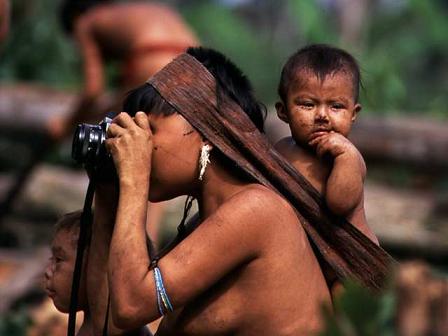INDIGENOUS (NATIVE) PEOPLE






Next >>>
Kalimantan
The main population groups live around Pontianak, Banjarmasin, and around the coastal areas from Balikpapan to Samarinda. The Dayaks live in sparsely populated areas near rivers. Most recent arrivals have settled in the coastal areas. Bugis and other immigrants from Sulawesi live mainly in Kalimantan Timur, with the Iban, Kayan, and other indigenous peoples. In the west, there are Malay immigrants from Sumatra and Malaysia. In Kalimantan Tengah, there are Dayaks and Chinese settlers. The people living around Banjarmasin are largely of Malay descent. The main faiths are Islam, Roman Catholicism, and Protestantism . Many of the people living upriver follow local religions. The main languages are dialects of Malay, Dayak, and Chinese.
South Africa
The new Constitution gives special rights to South Africa's many ethnic groups. Indigenous (native) and customary law still exists, though national law has higher authority. Representatives of the Xhosa, Zulu, and other black ethnic groups make up the Council of Traditional Leaders. This council advises the national government on the role of traditional leaders and on customary law. The Constitution also acknowledges the role and position of the Zulu monarch and allows for a Volkstaat Council to work toward creating a separate state for Afrikaners. The government abolished the Council, however, in 1998.
Australian Aborigines
Australian Aborigines, are the first people of Australia. The word aborigines comes from the Latin phrase ab origine, meaning from the beginning. When spelled with a small a, the word aborigines refers to any people whose ancestors were the first people to live in a country. Australia's Aborigines live on mainland Australia and the nearby islands, including Tasmania and the Torres Strait Islands. The Torres Strait Aborigines are known as Torres Strait Islanders. For more detailed information on the Aboriginal people of Tasmania.
Within Australia, the Aborigines are usually called Aboriginals. The ancestors of today's Aborigines arrived in Australia at least 50,000 years ago. Scientists believe that these first people came by boat from Southeast Asia, the closest land that was inhabited by human beings at that time. By 30,000 to 25,000 years ago, Aborigines had colonized most of the diverse regions of the country, from the tropical rain forests to the central deserts. There were probably from 500,000 to 1 million Aborigines living in Australia when European settlers first reached the island continent in 1788.
American Indians or Native Americans?
The native peoples of America were given the name Indians by the explorer Christopher Columbus, who thought he had reached a place called the Indies. At that time, each group of native peoples in the Americas had a name for itself. But the Indians did not have a name for themselves as a whole. Over time, the terms American Indian and Indian became widely used.
Today, several terms are used to refer to the native peoples of the Americas. They include Indians, American Indians, Native Americans, Amerinds, and Amerindians. There is no general agreement among Indians as to which term is preferred, though Amerinds and Amerindians are more widely used by scholars than by Indians themselves. Some Indians say that Native Americans is misleading because any person born in America is a native American.
The native peoples of Canada often use the terms First Nations, aboriginals, first peoples, and indigenous peoples. Most people of the Arctic prefer to be called Inuit, Yuit, or Aleuts, rather than Eskimos. The singular of Inuit is Inuk. Native Hawaiians are strongly opposed to being called Native Americans.
Many Indians prefer to identify themselves by tribal affiliation, such as Hopi and Cheyenne. However, many tribes acquired the names by which they are now known from other groups. For example, the Navajo received this name from the Spaniards, who called them the Apaches de Navajo to distinguish them from the Apache. Navajo was a Pueblo Indian word for an area of the Southwest. The Navajo, on the other hand, referred to themselves as Dine, which means "the people." Today, some members of this tribe are urging a return to the original name.
|

